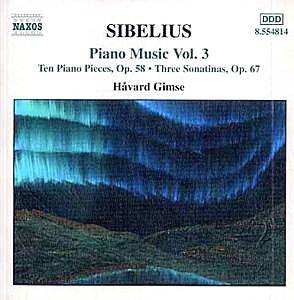 |
Jean SIBELIUS
(1865-1957)
|
Sibelius's piano music has often been dismissed as mere salon trinkets (admittedly, some of it is that), unworthy of the great symphonist and tossed off to pay for the booze. It is noticeable that an artist like Ashkenazy who, as a conductor, has made a considerable speciality of Sibelius, has shown no interest in him as a pianist. As a pianist who does not conduct, and with a special love of Sibelius's symphonies and orchestral music generally, I have looked at some of his piano works from time to time (none of the present ones, as it happens) with varying degrees of dismay. The first thing to be said of this disc, in spite of a few queries I shall have to make, is that Gimse has convinced me I should go back and look at this music again, and an artist can hardly hope to do more than that.
First of all, don't go to this music expecting it to sound like the orchestral music transcribed for the piano. The Sibelius orchestral sound could never work on the piano and he must have known it. Listening blind, I doubt if I would have recognised the composer at all except perhaps for a few moments in the Sonatinas. So much for what it isn't, but what is it? The opening Rêverie is impressionistic in texture though without much resemblance to Debussy or Ravel. I thought momentarily of Scott or even Scriabin, but there is not their decadent sultriness. The dry repeated notes of The Shepherd put me in mind of De Falla and I even thought of Stanford in Summer Song, and sometimes of Delius. It is interesting that the composers I thought of while listening to this are all in their various ways national composers from the fringes of Europe, and equally interesting that the obvious Nordic model, Grieg, is wholly absent.
Although Sibelius occasionally makes use of great washes of pedalled sound, on the whole his orchestral outlook leads him to a clear, often very brilliant, style of writing. These are not really amateur pieces and the two Rondinos, very much contrasted, would be welcome recital material. All round I think Sibelius has not been given enough credit for his attempt to find a way of writing for the piano which would work for him and be at the same time pianistic. His attempts in this direction may have been sporadic and never blossomed into a piece of any size, but he made them and we should not ignore them.
And as I said, I have to thank Gimse for these thoughts. I have often criticised pianists nowadays for failing to colour the various lines in the texture, or for not finding the proper balance between melody and accompaniment. Gimse has obviously thought about these things, and he is also a bold artist, willing to risk some over-the-top rubatos or to pitch into a presto recklessly. At least he makes you listen. I won't go as far as to say he has a singing tone - In the Evening surely lacks simple songfulness - but the slightly unnatural recording (was this a very small church with plenty of glass windows and a stone floor?) plus the possibility that Sibelius did not always place his melodies in the zone where the piano sings best mean that I'll wait to hear him again before deciding on that one.
I never really thought I'd be recommending a disc of Sibelius piano music. If you thought as I did, do give this a try, and you might be as surprised as I was.
Christopher Howell